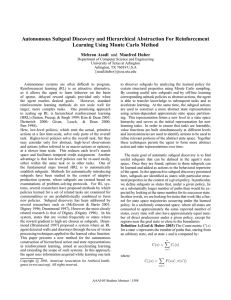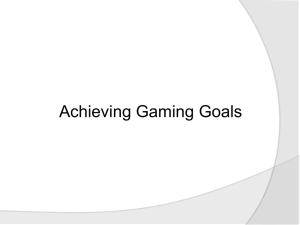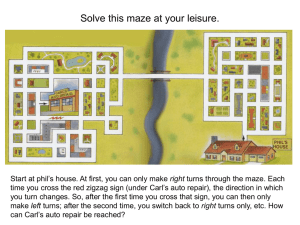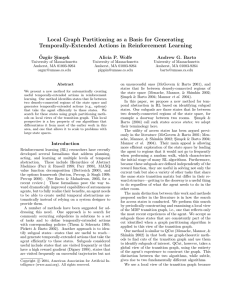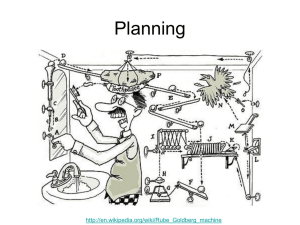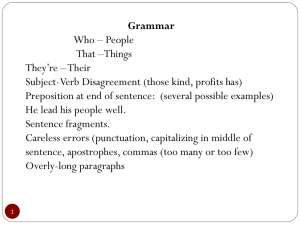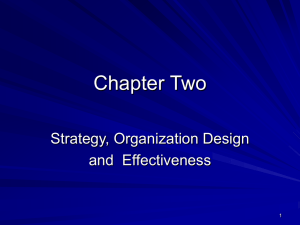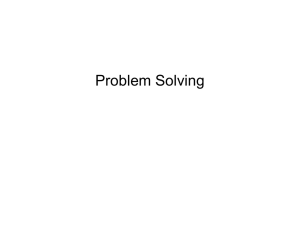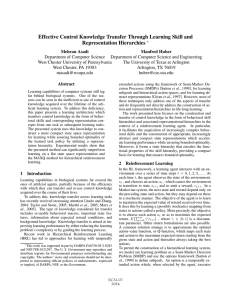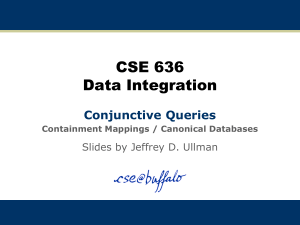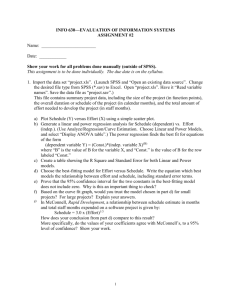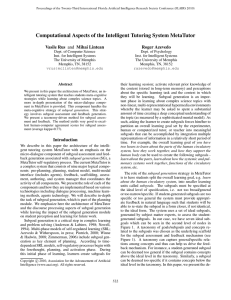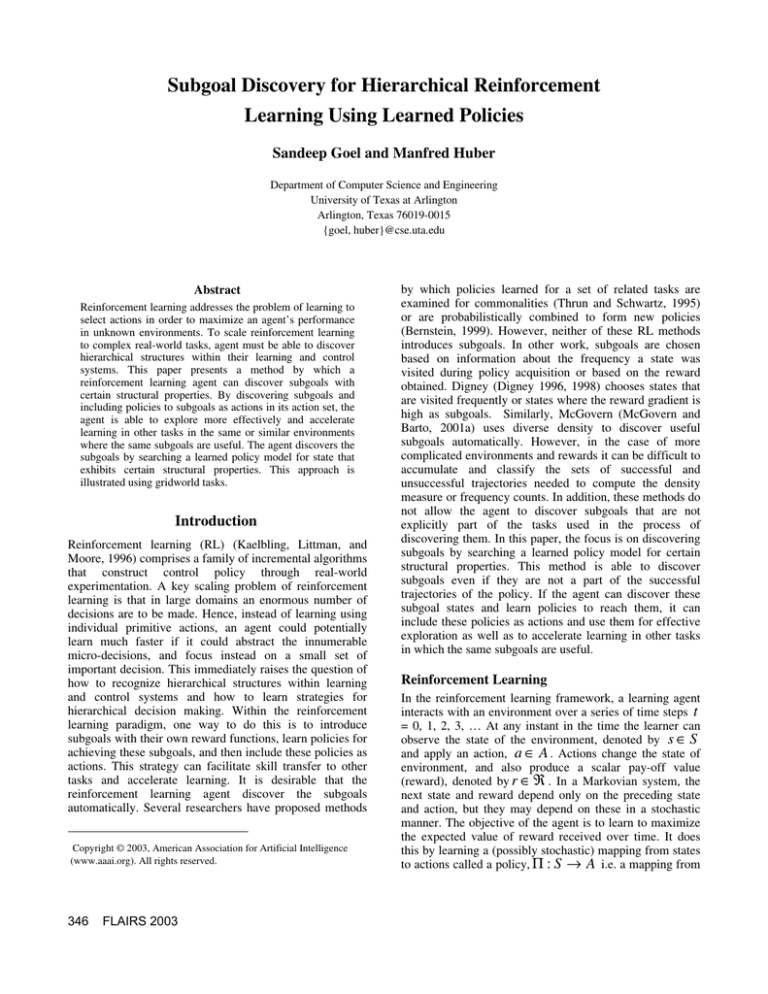
Subgoal Discovery for Hierarchical Reinforcement
Learning Using Learned Policies
Sandeep Goel and Manfred Huber
Department of Computer Science and Engineering
University of Texas at Arlington
Arlington, Texas 76019-0015
{goel, huber}@cse.uta.edu
Abstract
Reinforcement learning addresses the problem of learning to
select actions in order to maximize an agent’s performance
in unknown environments. To scale reinforcement learning
to complex real-world tasks, agent must be able to discover
hierarchical structures within their learning and control
systems. This paper presents a method by which a
reinforcement learning agent can discover subgoals with
certain structural properties. By discovering subgoals and
including policies to subgoals as actions in its action set, the
agent is able to explore more effectively and accelerate
learning in other tasks in the same or similar environments
where the same subgoals are useful. The agent discovers the
subgoals by searching a learned policy model for state that
exhibits certain structural properties. This approach is
illustrated using gridworld tasks.
Introduction
Reinforcement learning (RL) (Kaelbling, Littman, and
Moore, 1996) comprises a family of incremental algorithms
that construct control policy through real-world
experimentation. A key scaling problem of reinforcement
learning is that in large domains an enormous number of
decisions are to be made. Hence, instead of learning using
individual primitive actions, an agent could potentially
learn much faster if it could abstract the innumerable
micro-decisions, and focus instead on a small set of
important decision. This immediately raises the question of
how to recognize hierarchical structures within learning
and control systems and how to learn strategies for
hierarchical decision making. Within the reinforcement
learning paradigm, one way to do this is to introduce
subgoals with their own reward functions, learn policies for
achieving these subgoals, and then include these policies as
actions. This strategy can facilitate skill transfer to other
tasks and accelerate learning. It is desirable that the
reinforcement learning agent discover the subgoals
automatically. Several researchers have proposed methods
Copyright © 2003, American Association for Artificial Intelligence
(www.aaai.org). All rights reserved.
346
FLAIRS 2003
by which policies learned for a set of related tasks are
examined for commonalities (Thrun and Schwartz, 1995)
or are probabilistically combined to form new policies
(Bernstein, 1999). However, neither of these RL methods
introduces subgoals. In other work, subgoals are chosen
based on information about the frequency a state was
visited during policy acquisition or based on the reward
obtained. Digney (Digney 1996, 1998) chooses states that
are visited frequently or states where the reward gradient is
high as subgoals. Similarly, McGovern (McGovern and
Barto, 2001a) uses diverse density to discover useful
subgoals automatically. However, in the case of more
complicated environments and rewards it can be difficult to
accumulate and classify the sets of successful and
unsuccessful trajectories needed to compute the density
measure or frequency counts. In addition, these methods do
not allow the agent to discover subgoals that are not
explicitly part of the tasks used in the process of
discovering them. In this paper, the focus is on discovering
subgoals by searching a learned policy model for certain
structural properties. This method is able to discover
subgoals even if they are not a part of the successful
trajectories of the policy. If the agent can discover these
subgoal states and learn policies to reach them, it can
include these policies as actions and use them for effective
exploration as well as to accelerate learning in other tasks
in which the same subgoals are useful.
Reinforcement Learning
In the reinforcement learning framework, a learning agent
interacts with an environment over a series of time steps t
= 0, 1, 2, 3, … At any instant in the time the learner can
observe the state of the environment, denoted by s ∈ S
and apply an action, a ∈ A . Actions change the state of
environment, and also produce a scalar pay-off value
(reward), denoted by r ∈ ℜ . In a Markovian system, the
next state and reward depend only on the preceding state
and action, but they may depend on these in a stochastic
manner. The objective of the agent is to learn to maximize
the expected value of reward received over time. It does
this by learning a (possibly stochastic) mapping from states
to actions called a policy, Π : S → A i.e. a mapping from
states s ∈ S to actions a ∈ A . More precisely, the
objective is to choose each action so as to maximize the
expected return:
∞
R = E[∑ γ i ri ]
(1)
i =0
where γ ∈ [0,1) is a discount-rate parameter and ri refers
to the pay-off at time i. A common approach to solve this
problem is to approximate the optimal state-action value
function, or Q-function (Watkins, 1989), Q: S × A → ℜ
which maps states s ∈ S and actions a ∈ A to scalar
values. In particular, Q ( s , a ) represents the expected
discounted sum of future rewards if action a is taken in
state s and the optimal policy is followed afterwards.
Hence Q, once learned, allows the learner to maximize R
by picking actions greedily with respect to Q:
Π ( s ) = arg max Q( s, a )
(2)
a∈A
The value function Q is learned on-line through
experimentation. Suppose that during learning the learner
executes action a in state s , which leads to a new state s ’
and the immediate pay-off r s ,a . In this case Q-learning
uses this state transition to update Q ( s , a) according to:
Q ( s , a ) ← (1 − α )Q ( s , a ) + α ( rs , a + γ max Q ( s ’, a ))
a
The scalar
(3)
α ∈ [0,1) is the learning rate.
Subgoal Extraction
An example that shows that subgoals can be useful is a
room to room navigation task where the agent should
discover the utility of doorways as subgoals. If the agent
can recognize that a doorway is a subgoal, then it can learn
a policy to reach the doorway. This policy can accelerate
learning on related tasks in the same or similar
environments by allowing the agent to move between the
rooms using single actions. The idea of using subgoals
however is not confined to gridworlds or navigation tasks.
Other tasks should also benefit from subgoal discovery. For
example, consider a game in which the agent must find a
key to open a door before it can proceed. If it can discover
that having a key is a useful subgoal, then it will more
quickly be able to learn how to advance from level to level
(McGovern and Barto, 2001b).
In the approach described in this paper, the focus is on
discovering useful subgoals that can be defined in the
agent’s state space. Policies to those subgoals are then
learned and added as actions. In a regular space (regular
space here refers to a uniformly connected state space)
every state will have approximately the same expected
number of direct predecessors under a given policy, except
for regions near the goal state or close to boundaries (where
the space is not regular). In a regular and unconstrained
space, if the count of all the predecessors for every state
under a given policy is accumulated and a curve for these
counts along a chosen path is plotted, the expected curve
would behave like the positive part of a quadratic, and the
expected ratio of gradients along such a curve would be a
positive constant. In the approach presented here, a subgoal
state is a state with the following structural property: the
state space trajectories originating from a significantly
larger than expected number of states lead to the subgoal
state while its successor state does not have this property.
Such states represent a “funnel” for the given policy. To
identify such states it is possible to evaluate the ratio of the
gradients of the count curve before and after the subgoal
state. Consider a path under a given policy going through a
subgoal state. The predecessors of the subgoal state along
this path lie in a relatively unconstrained space and thus the
count curve for those states should be quadratic. However,
the dynamics changes strongly at the subgoal state. There
will be a strong increase in the count and the curve will
become steeper as the path approaches a subgoal state. On
the other hand, the increase in the count can be expected to
be much lower for the successor state of the subgoal as it
again lies in a relatively unconstrained space. Thus the ratio
of the gradients at this point will be high and easily
distinguishable. Let C( s ) represent the count of
predecessors for a state s under a given policy, and Ct( s )
is the count of predecessors that can reach s in exactly t
steps:
C1 (s) =
∑ P ( s s ’, Π ( s ’))
C t +1 ( s ) =
∑ P ( s s ’, Π ( s ’)) C
C (s) =
(4)
s≠ s’
s≠s’
n
∑C
i =1
i
(s)
t
( s ’)
(5)
(6)
where n is such that Cn+1= Cn or n = number of states,
whichever is smaller. The condition s ≠ s ’ prevents the
counting of one step loops. P( s | s ’, s ’)) is the
probability of reaching state s from state s’ by taking action
s ’) (in a deterministic world the probability is 1 or 0). If
there are loops within the policy, then the counts for the
states in the loop will become very high. This implies that,
if no precautions are taken, the gradient criteria used here
might also identify states in the loop as subgoals.
To calculate the ratio along a path under the given policy,
let C ( s1 ) be the predecessor count for the initial state of
the path and C ( st ) be the count for the state the agent will
be in after executing t steps from the initial state. The
slope of the curve at step t , ∆ t can be computed as:
∆ t = C ( s t ) − C ( st −1 )
(7)
FLAIRS 2003
347
To identify subgoals, the gradient ratio
∆t
∆t
is computed if
+1
∆ t > ∆ t +1 (If ∆ t < ∆ t +1 then the ratio is less then 1 and
state does not fit the criterion. Avoiding the computation of
the ratio for such points thus saves computational effort). If
the computed ratio is higher then a specified threshold,
state st will be considered a potential subgoal. The
threshold here depends largely on the characteristics of the
state space but can often be computed independent of the
particular environment.
The subgoal extraction technique presented here has been
illustrated using a simple gridworld navigation problem.
Figure 1 shows a four-room example environment on a
20x20 grid. For these experiments, the goal state was
placed in the lower right portion and each trial started from
same state in the left upper corner as shown in Figure1.
using Monte Carlo sampling methods. The agent then
evaluates the ratio of gradients along the count curve by
choosing random paths, and picks the states in which the
ratio is higher then the specified threshold as subgoal states.
For this experiment the count curve along one of the
randomly chosen paths through a subgoal state is shown in
Figure 2. The path chosen is indicated in Figure 1 and the
subgoal state is highlighted both in Figure 1 and Figure 2.
The value for the gradient ratio at step 4 (which is in
regular space) is 1.444 while it is 95.0 at step 6 (which is a
subgoal state).
To show that the gradient ratio in the unconstrained portion
of the state space and at a subgoal state are easily
distinguishable, histograms for the distribution of these
ratios in randomly generated environments, are shown in
Figure 3.
Figure 2. Count curve along a randomly chosen path
through a subgoal state under the learned policy.
Figure 1. Set of primitive actions (right) and gridworld(left)
with the initial state in the upper left corner, the goal in the
lower right portion and a random path under the learned
policy.
The action space consists of eight primitive actions (North,
East, West, South, North-west, North-east, South-west, and
South-east). The world is deterministic and each action
succeeds in moving the agent in the chosen direction. With
every action the agent receives a negative reward of -1 for
a straight action and -1.2 for a diagonal action. In addition,
the agent gets a reward of +10 when it reaches the goal
state. The agent learns using Q-OHDUQLQJ DQG -greedy
exploration. It starts with 90 (which means 90% of the
time it tries to explore by choosing a random action) and
gradually decreases the exploration to
0.05. In this
experiment the predecessor count for every state is
computed exhaustively using equations 4, 5, and 6.
However, for large state spaces counts can be approximated
348
FLAIRS 2003
The Histogram shows data collected from 12 randomly
generated 20x20 gridworlds with randomly placed rooms
and goals. Each run learns a policy model for the respective
task using Q-learning and computes the counts of
predecessors for every state using equations 4, 5, and 6.
Gradient ratios for 40 random paths in each environment
are shown in the histogram.
The subgoal states that the agent discovered in this
experiment are shown in Figure 4. The subgoal state
leading to the left room is identified here due to its
structural properties under the policy and despite the fact
that it does not lie on the successful paths between the start
and the goal state. The agent did not discover the doorway
in the smaller room as a subgoal state because the number
of state for which the policy leads through the subgoal is
small compared to the other rooms and hence the count for
this subgoal state is not influenced significantly by the
structural property of the state.
To show that the method for discovering subgoals
discussed above is not confined to gridworlds or navigation
tasks, random worlds with 1600 states were generated. In
these worlds fixed numbers of actions were available in
each state. Each action in the state s connects to a randomly
chosen state s’ in their local neighborhood. Then the count
metric was established and gradient ratios were computed
for these spaces with and without a subgoal. The results
showed that the gradient ratios in the unconstrained portion
of the state space and at a subgoal state are again easily
distinguishable.
Hierarchical Policy Formation
The motivation for discovering subgoals is the effect that
available policies that lead to subgoals have on the agent’s
exploration and speed of learning in related tasks in the
same or similar environments. If the agent randomly selects
exploratory primitive actions, it is likely to remain within
the more strongly connected regions of the state space. A
policy for achieving a subgoal region, on the other hand,
will tend to connect separate strongly connected areas. For
example, in a room-to-room navigation task, navigation
using primitive movement commands produces relatively
strongly connected dynamics within each room but not
between rooms. A doorway links two strongly connected
regions. By adding a policy to reach a doorway subgoal the
rooms become more closely connected. This allows the
agent to more uniformly explore its environment. It has
been shown that the effect on exploration is one of two
main reasons that extended actions can be able to
dramatically affect learning (McGovern, 1998).
Learning policies to subgoals
Figure 3. Histogram for the distribution of the gradient
ratio in regular space (dark bars) and at subgoal states
(light bars).
Figure 4. Subgoals states discovered by the agent (light
gray states)
To take advantage of the subgoal states, the agent uses Qlearning to learn a policy to each of the subgoals discovered
in the previous step. These policies, which lead to
respective subgoal states (subgoal policies) are added to the
action set of the agent.
Learning hierarchical policies. One reason that it is
important for the learning agent to be able to detect subgoal
states is the effect of subgoal policies on the rate of
convergence to a solution. If the subgoals are useful then
learning should be accelerated. To ascertain that these
subgoals help the agent to improve its policy more quickly,
two experiments were performed where the agent learned a
new task with and without the subgoal policies. The same
20x20 grid-world with three rooms was used to illustrate
the results. Subgoal policies were included in the action set
of the agent (Subg1, Subg2). The task was changed by
moving the goal to left hand room as shown in Figure 5.
The agent solves the new task using Q-learning with an
exploration of 5%.
The action sequence under the policy learned for the new
task, when its action set included the subgoal policies is
(Subg2, South-west, South, South, South, South) where
Subg2 refers to the subgoal policy which leads to the state
as shown in Figure 5. Figure 6 shows the learning curves
when the agent was using the subgoal policies and when it
was using only primitive actions. The learning performance
is compared in terms of the total reward that the agent
would receive under the learned policy at that point of the
learning process. The curves in Figure 6 are averaged over
10 learning runs. Only an initial part of data is plotted to
compare the two learning curves; with primitives only the
agent is still learning after 150,000 learning steps while
with subgoal policies the policy has already converged.
After 400,000 learning steps the agent without subgoal
FLAIRS 2003
349
policies also converges to the same overall performance.
The vertical intervals along the curve indicate one standard
deviation in each direction at that point.
subgoals in the action set can significantly accelerate
learning in other, related tasks. While the example shown
here are gridworld tasks, the presented approach for
discovering and using subgoals is not confined to
gridworlds or navigation tasks.
Acknowledgements
This work was supported in part by NSF ITR-0121297 and
UTA REP/RES-Huber-CSE.
References
Bernstein, D. S. (1999). Reusing old policies to accelerate
learning on new MDPs (Technical Report UM-CS-1999026). Dept. of Computer Science, Univ. of Massachusetts,
Amherst, MA.
Digney, B. (1996). Emergent hierarchical structures:
Learning
reactive/hierarchical
relationships
in
reinforcement environments. From animals to animats 4:
SAB 96. MIT Press/Bradford Books.
Figure 5. New task with goal state in the left hand room.
Digney, B. (1998). Learning hierarchical control structure
for multiple tasks and changing environments. From
animals to animats 5: SAB 98.
Kaelbling, L. P., Littman, M. L., and Moore, A. W.
‘‘Reinforcement Learning: A Survey,’’ Journal of Artificial
Intelligence Research, Volume 4, 1996
McGovern, A., and Barto, A. G. (2001a). Automatic
Discovery of Subgoals in Reinforcement learning using
th
Diverse Density. Proceedings of the 18 International
Conference on Machine Learning, pages 361-368.
McGovern, A. (1998).
Roles of macro-actions in
accelerating reinforcement learning. Master’s thesis, U. of
Massachusetts, Amherst. Also Technical Report 98-70.
McGovern, A., and Barto, A. G. (2001b). Accelerating
Reinforcement Learning through the Discovery of Useful
Subgoals. Proceedings of the 6th International Symposium
on Artificial Intelligence, Robotics and Automation in
Space.
Figure 6. Comparison of learning speed using subgoal
policies and using primitive actions only.
Conclusions
This paper presents a method for discovering subgoals by
searching a learned policy model for states that exhibit a
funneling property. These subgoals are discovered by
studying the dynamics along the predecessor count curve
and can include states that are not an integral part of the
initial policy. The experiments presented here shows that
discovering subgoals and including policies for these
350
FLAIRS 2003
Sutton, R. S. & Barto, A. G. (1998). Reinforcement
learning: an Introduction. Cambridge, MA: MIT Press.
Sutton, R.S. (1988). Learning to predict by the methods of
temporal differences. Machine Learning 3: 9-44.
Thrun, S. B., & Schwartz, A. (1995). Finding structure in
reinforcement learning. NIPS 7 (pp. 385-392). San Mateo,
CA: Morgan Kaufmann.
Watkins, Christopher J.C.H. (1989). Learning from delayed
rewards. PhD thesis, Dept. of Psychology, Univ. of
Cambridge.

